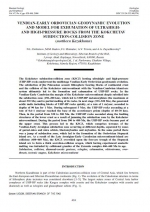Добрый день, Коллеги. Важное сообщение, просьба принять участие. Музей Ферсмана ищет помощь для реставрационных работ в помещении. Подробности по ссылке
Vendian-early ordovican geodynamic evolution and model for exhumation of ultrahigh- and high-pressure rocks from the Kokchetav subduction-collision zone (northern Kazakhstan)
The Kokchetav subduction-collision zone (KSCZ) hosting ultrahigh- and high-pressure (UHP-HP) rocks underwent the multistage Vendian-Early Ordovician geodynamic evolution. The subduction of the Paleoasian oceanic lithosphere bearing blocks of continental crust and the collision of the Kokchetav microcontinent with the Vendian-Cambrian island-arc system ultimately led to the formation and exhumation of UHP-HP rocks. In the Vendian-Early Cambrian the margin of the Kokchetav microcontinent deeply subsided into the subduction zone (150–200 km), which led to UHP-HP metamorphism (the maximum at about 535 Ma) and to partial melting of its rocks. In next stage (535–528 Ma), the generated acidic melts including blocks of UHP-HP rocks quickly, at a rate of 1 m/year, ascended to depths of 90 km for 1 Myr. During subsequent 5 Myr, the UHP-HP rocks ascending at a rate of 0.6–1 cm/year reached the base of the accretionary prism (depths of 60–30 km). Then, in the period from 528 to 500 Ma, the UHP-HP rocks ascended along the faulting structures of the lower crust as a result of jamming the subduction zone by the Kokchetav microcontinent. During the period from 500 to 480 Ma, the UHP-HP rocks became part of the upper crust. This process led to the KSCZ, which comprises terranes of the Vendian-Early Arenigian subduction zone occurring at different depths, separated by zones of garnet-mica and mica schists, blastomylonites and mylonites. In the same period there was a jump of subduction zone, which led to the formation of the Ordovician Stepnyak island arc. As a result of the Late Arenigian-Early Caradocian microcontinent-island arc collisions (480–460 Ma), the KSCZ overrided upon the fore-arc trough of the Stepnyak island arc to form a thick accretion-collision orogen, which having experienced anatectic melting was intruded by collisional granites of the Zerenda complex 460–440 Ma in age.




